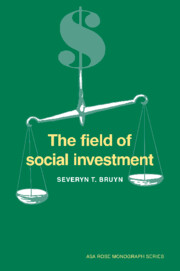Book contents
- Frontmatter
- Contents
- Preface
- Part I The idea of social investment
- 1 The meaning of social investment
- 2 The activity of social investment
- 3 A theory of social investment
- Part II Social criteria and research
- Part III Global social investment
- Epilogue: Social investment as a self-correcting movement in the market system
- Notes
- Bibliography
- Name index
- Subject index
- Title in the Series
2 - The activity of social investment
Published online by Cambridge University Press: 19 January 2010
- Frontmatter
- Contents
- Preface
- Part I The idea of social investment
- 1 The meaning of social investment
- 2 The activity of social investment
- 3 A theory of social investment
- Part II Social criteria and research
- Part III Global social investment
- Epilogue: Social investment as a self-correcting movement in the market system
- Notes
- Bibliography
- Name index
- Subject index
- Title in the Series
Summary
The field of social investment is the study and the practice of making financial decisions in the context of society. Our interest here is the way various types of investors make decisions with a social purpose, with special emphasis on how they integrate social and economic criteria of investment.
Social investors in the United States may be divided into two groups: (1) direct investors, and (2) stock market investors. The distinction between the two types is not always sharp, but in general direct investors place funds into nonprofit corporations or socially structured corporations, seeking a direct impact on the development of social values in the corporations. Direct investors may aim to solve social problems through such organizations or help them realize social goals by supplying capital to them. These investors include business corporations that give directly from their pretax profits for “charitable purposes”, corporations making low-interest loans to assist in community development, and nonprofit foundations designed especially to invest for social (educational, religious, and health) purposes.
Stock market investors differ from direct investors in that they purchase shares selectively in profit enterprises listed on the New York and American stock exchanges. They invest for economic gain but utilize social criteria in making their decisions. They do not always exercise direct influence on the corporations, nor do they seek to contribute directly to the welfare of a particular community.
- Type
- Chapter
- Information
- The Field of Social Investment , pp. 16 - 37Publisher: Cambridge University PressPrint publication year: 1987

